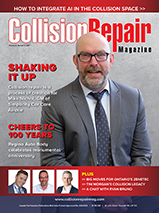ROUGHED UP
IS YOUR BUSINESS READY FOR HIGH-TECH SUPERABRASIVES?
As manufacturers use more complicated materials and rely more and more on mixedmaterial combinations formed using structural adhesives in their vehicle designs, traditional abrasives are no longer appropriate for use in all repairs. Automotive manufacturers are expected to increase their spending on synthetic superabrasives over the next few years. Research suggests that industry spending in 2026 could be more than 150 percent of spending in 2020.
While synthetic superabrasives are more expensive than traditional abrasive, these products will help reduce labour requirements for performing repairs on all vehicles, and, in some cases, are required by OEM repair procedures. Across the industry, abrasives are emerging in various shapes and sizes for easier application in complex structures.
Investors in automotive abrasive manufacturing businesses are in for welcome surprise. As a result of new automotive materials, collision repair facilities are about to have to invest a whole lot into rethinking their approach to abrasives.
“Abrasives are among the most widely used automotive collision repair products. Manufacturers are rolling out abrasives in various shapes and sizes for easier application in complex structures. Advanced product offerings help to significantly reduce the overall rework time, enhance repair efficiency, and enhance operational productivity, which may complement industry growth,” writes DecResearch, an online aggregator of information from industry reports in a press release covering the automotive repair sector.
DecResearch isn’t alone in its belief that auto repairers should expect to see a transformation in abrasives over the coming years. In fact, the automotive sector is also undergoing such a transition.
According to Technavio Research, global spending on abrasives is expected to increase by $12.35 billion by 2024. Much of this growth will come from the automotive sector.
“Abrasives find a large number of applications in the automotive industry. They are widely used for sizing engine parts, deburring, cleaning, and also for repairing and maintaining autobody, interiors, and accessories,” Technavio’s media relations chief Jesse Maida explains.
Part of the reason for the increased investment in abrasives from OEMs is the increasing role of high-tech materials– including superalloys and mixed ceramosynthetic coatings–in their vehicles. To work with these mixed materials with specialized properties, a roll of sandpaper just ain’t going to cut it. New, specially designed superabrasives must be used.
Another firm, Research Dive, says that there will be a huge growth in the synthetic superabrasive market by 2026, with an annual growth rate above six percent! Of course, the automotive sector has been making use of abrasives for these applications for decades, and auto repairers have been following in their lead for just as long. What OEMs haven’t invested as much in are in abrasives designed specifically for their higher-tech components.
Obviously, the abrasive needed in vehicle sensors are more similar to those used by any electronics manufacturers. This is why OEMs are spending more on specialized abrasives that can work on semiconductors and silicon chips–and why repair facilities looking to drastically reduce the estimates they make on damaged modern vehicles might have to start investing in their use as well.





















